Pain Management | Nursing Assignment
VerifiedAdded on 2022/09/18
|8
|2416
|35
AI Summary
Contribute Materials
Your contribution can guide someone’s learning journey. Share your
documents today.
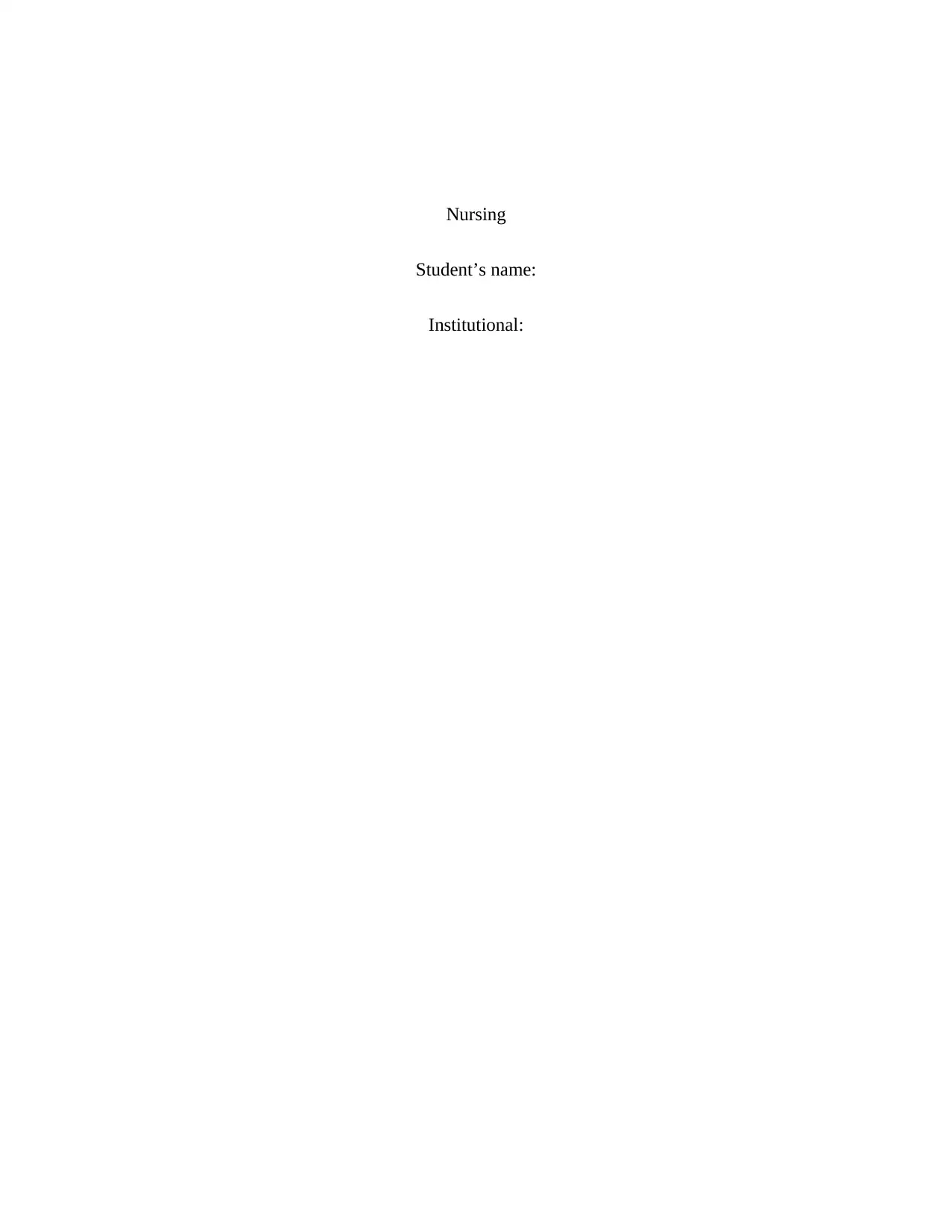
Nursing
Student’s name:
Institutional:
Student’s name:
Institutional:
Secure Best Marks with AI Grader
Need help grading? Try our AI Grader for instant feedback on your assignments.
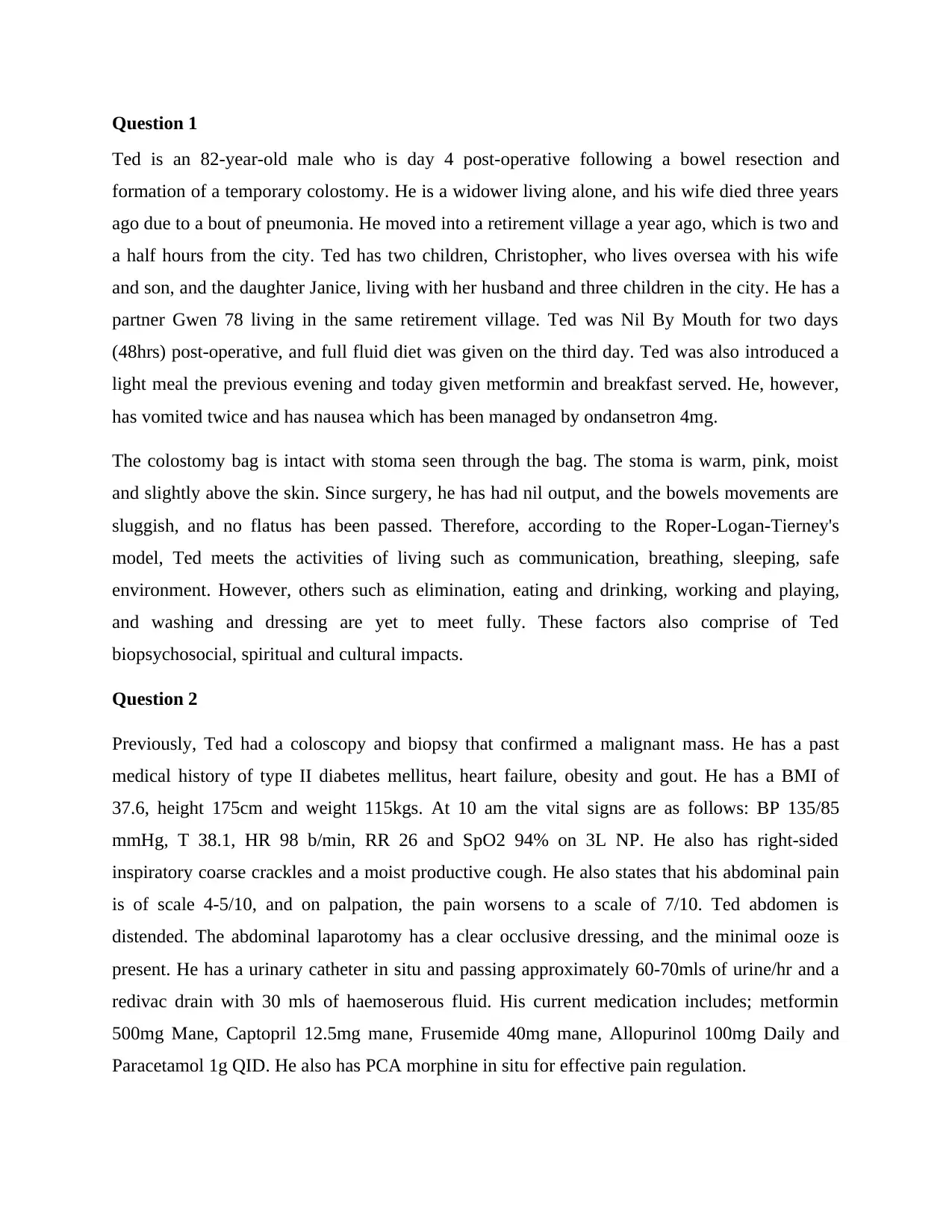
Question 1
Ted is an 82-year-old male who is day 4 post-operative following a bowel resection and
formation of a temporary colostomy. He is a widower living alone, and his wife died three years
ago due to a bout of pneumonia. He moved into a retirement village a year ago, which is two and
a half hours from the city. Ted has two children, Christopher, who lives oversea with his wife
and son, and the daughter Janice, living with her husband and three children in the city. He has a
partner Gwen 78 living in the same retirement village. Ted was Nil By Mouth for two days
(48hrs) post-operative, and full fluid diet was given on the third day. Ted was also introduced a
light meal the previous evening and today given metformin and breakfast served. He, however,
has vomited twice and has nausea which has been managed by ondansetron 4mg.
The colostomy bag is intact with stoma seen through the bag. The stoma is warm, pink, moist
and slightly above the skin. Since surgery, he has had nil output, and the bowels movements are
sluggish, and no flatus has been passed. Therefore, according to the Roper-Logan-Tierney's
model, Ted meets the activities of living such as communication, breathing, sleeping, safe
environment. However, others such as elimination, eating and drinking, working and playing,
and washing and dressing are yet to meet fully. These factors also comprise of Ted
biopsychosocial, spiritual and cultural impacts.
Question 2
Previously, Ted had a coloscopy and biopsy that confirmed a malignant mass. He has a past
medical history of type II diabetes mellitus, heart failure, obesity and gout. He has a BMI of
37.6, height 175cm and weight 115kgs. At 10 am the vital signs are as follows: BP 135/85
mmHg, T 38.1, HR 98 b/min, RR 26 and SpO2 94% on 3L NP. He also has right-sided
inspiratory coarse crackles and a moist productive cough. He also states that his abdominal pain
is of scale 4-5/10, and on palpation, the pain worsens to a scale of 7/10. Ted abdomen is
distended. The abdominal laparotomy has a clear occlusive dressing, and the minimal ooze is
present. He has a urinary catheter in situ and passing approximately 60-70mls of urine/hr and a
redivac drain with 30 mls of haemoserous fluid. His current medication includes; metformin
500mg Mane, Captopril 12.5mg mane, Frusemide 40mg mane, Allopurinol 100mg Daily and
Paracetamol 1g QID. He also has PCA morphine in situ for effective pain regulation.
Ted is an 82-year-old male who is day 4 post-operative following a bowel resection and
formation of a temporary colostomy. He is a widower living alone, and his wife died three years
ago due to a bout of pneumonia. He moved into a retirement village a year ago, which is two and
a half hours from the city. Ted has two children, Christopher, who lives oversea with his wife
and son, and the daughter Janice, living with her husband and three children in the city. He has a
partner Gwen 78 living in the same retirement village. Ted was Nil By Mouth for two days
(48hrs) post-operative, and full fluid diet was given on the third day. Ted was also introduced a
light meal the previous evening and today given metformin and breakfast served. He, however,
has vomited twice and has nausea which has been managed by ondansetron 4mg.
The colostomy bag is intact with stoma seen through the bag. The stoma is warm, pink, moist
and slightly above the skin. Since surgery, he has had nil output, and the bowels movements are
sluggish, and no flatus has been passed. Therefore, according to the Roper-Logan-Tierney's
model, Ted meets the activities of living such as communication, breathing, sleeping, safe
environment. However, others such as elimination, eating and drinking, working and playing,
and washing and dressing are yet to meet fully. These factors also comprise of Ted
biopsychosocial, spiritual and cultural impacts.
Question 2
Previously, Ted had a coloscopy and biopsy that confirmed a malignant mass. He has a past
medical history of type II diabetes mellitus, heart failure, obesity and gout. He has a BMI of
37.6, height 175cm and weight 115kgs. At 10 am the vital signs are as follows: BP 135/85
mmHg, T 38.1, HR 98 b/min, RR 26 and SpO2 94% on 3L NP. He also has right-sided
inspiratory coarse crackles and a moist productive cough. He also states that his abdominal pain
is of scale 4-5/10, and on palpation, the pain worsens to a scale of 7/10. Ted abdomen is
distended. The abdominal laparotomy has a clear occlusive dressing, and the minimal ooze is
present. He has a urinary catheter in situ and passing approximately 60-70mls of urine/hr and a
redivac drain with 30 mls of haemoserous fluid. His current medication includes; metformin
500mg Mane, Captopril 12.5mg mane, Frusemide 40mg mane, Allopurinol 100mg Daily and
Paracetamol 1g QID. He also has PCA morphine in situ for effective pain regulation.

Ted is Obese since his BMI is 37.6, which is above the normal range of 18.5 to 24.5 in adults.
His heart rate is a bit higher (average range=75b/min) and also the respiratory rate is a bit higher.
This is most likely due to heart failure. His current medication captopril is being administered to
manage his heart failure. He also has type II diabetes mellitus, and this is the reason for
Metformin administration while allopurinol is used to manage gout. Metformin act by decreasing
the production of hepatic glucose, lowering the intestinal absorption of glucose and improving
the sensitivity of insulin by increasing the peripheral utilization and uptake of glucose (Rena,
Hardie, & Pearson, 2017). Ted's temperature of 38.1 degree Celsius is above the normal range,
and this is a sign of infection. The cardinal signs of infection in the body includes fever, pain,
redness and swelling (Norman, 2016). His wound should, therefore, be cleaned and checked
regularly to prevent infection. Paracetamol is analgesic, and antipyretic hence is administered to
reduce pain and reduce fever.
Ted should be assessed, and all the information and cues collected to be utilized to identify
problems that need to address in regard to his health. Some of the nursing problems identified for
Ted are as follows. Impaired physical mobility (Gordon, 2014) related to pain and
musculoskeletal impairment as evidence by the patient’s reluctance to attempt movement. Ted
has undergone surgery hence impaired musculoskeletal system, also altered nutrition less than
body required requirements (Gordon, 2014) related to the inability to procure adequate amounts
of foods as evidence by patient vomiting. Ted vomited after being introduced to meals which
may lead to altered nutrition. There is also a self-care deficit related to an energy deficit as
patient’s inability toileting task independently. Pain-related to post-operative pain as evidenced
by patient reporting pain is also another problem for Ted. Also, anxiety related to surgical
procedure as evidenced by the patient being restless and Body image disturbance related to the
presence of colostomy bag. Moreover, Ted is at risk of infection due to the broken skin as a
result of surgery and also the presence of indwelling catheters. These problems, therefore, have
to be addressed and considered while making a care plan for Ted. Proper interventions have to be
implemented to ensure that Ted’s needs are met.
Question 3
Goals
His heart rate is a bit higher (average range=75b/min) and also the respiratory rate is a bit higher.
This is most likely due to heart failure. His current medication captopril is being administered to
manage his heart failure. He also has type II diabetes mellitus, and this is the reason for
Metformin administration while allopurinol is used to manage gout. Metformin act by decreasing
the production of hepatic glucose, lowering the intestinal absorption of glucose and improving
the sensitivity of insulin by increasing the peripheral utilization and uptake of glucose (Rena,
Hardie, & Pearson, 2017). Ted's temperature of 38.1 degree Celsius is above the normal range,
and this is a sign of infection. The cardinal signs of infection in the body includes fever, pain,
redness and swelling (Norman, 2016). His wound should, therefore, be cleaned and checked
regularly to prevent infection. Paracetamol is analgesic, and antipyretic hence is administered to
reduce pain and reduce fever.
Ted should be assessed, and all the information and cues collected to be utilized to identify
problems that need to address in regard to his health. Some of the nursing problems identified for
Ted are as follows. Impaired physical mobility (Gordon, 2014) related to pain and
musculoskeletal impairment as evidence by the patient’s reluctance to attempt movement. Ted
has undergone surgery hence impaired musculoskeletal system, also altered nutrition less than
body required requirements (Gordon, 2014) related to the inability to procure adequate amounts
of foods as evidence by patient vomiting. Ted vomited after being introduced to meals which
may lead to altered nutrition. There is also a self-care deficit related to an energy deficit as
patient’s inability toileting task independently. Pain-related to post-operative pain as evidenced
by patient reporting pain is also another problem for Ted. Also, anxiety related to surgical
procedure as evidenced by the patient being restless and Body image disturbance related to the
presence of colostomy bag. Moreover, Ted is at risk of infection due to the broken skin as a
result of surgery and also the presence of indwelling catheters. These problems, therefore, have
to be addressed and considered while making a care plan for Ted. Proper interventions have to be
implemented to ensure that Ted’s needs are met.
Question 3
Goals
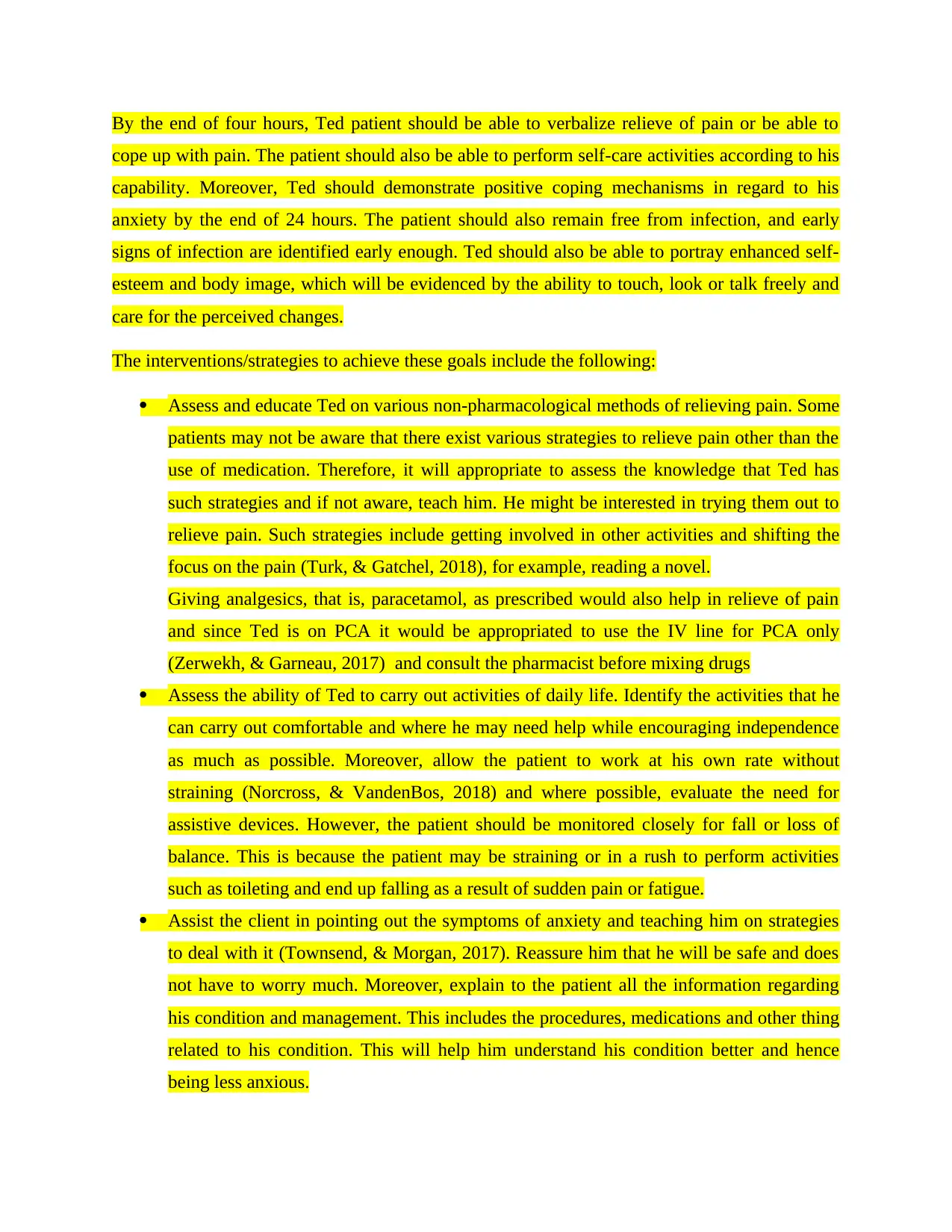
By the end of four hours, Ted patient should be able to verbalize relieve of pain or be able to
cope up with pain. The patient should also be able to perform self-care activities according to his
capability. Moreover, Ted should demonstrate positive coping mechanisms in regard to his
anxiety by the end of 24 hours. The patient should also remain free from infection, and early
signs of infection are identified early enough. Ted should also be able to portray enhanced self-
esteem and body image, which will be evidenced by the ability to touch, look or talk freely and
care for the perceived changes.
The interventions/strategies to achieve these goals include the following:
Assess and educate Ted on various non-pharmacological methods of relieving pain. Some
patients may not be aware that there exist various strategies to relieve pain other than the
use of medication. Therefore, it will appropriate to assess the knowledge that Ted has
such strategies and if not aware, teach him. He might be interested in trying them out to
relieve pain. Such strategies include getting involved in other activities and shifting the
focus on the pain (Turk, & Gatchel, 2018), for example, reading a novel.
Giving analgesics, that is, paracetamol, as prescribed would also help in relieve of pain
and since Ted is on PCA it would be appropriated to use the IV line for PCA only
(Zerwekh, & Garneau, 2017) and consult the pharmacist before mixing drugs
Assess the ability of Ted to carry out activities of daily life. Identify the activities that he
can carry out comfortable and where he may need help while encouraging independence
as much as possible. Moreover, allow the patient to work at his own rate without
straining (Norcross, & VandenBos, 2018) and where possible, evaluate the need for
assistive devices. However, the patient should be monitored closely for fall or loss of
balance. This is because the patient may be straining or in a rush to perform activities
such as toileting and end up falling as a result of sudden pain or fatigue.
Assist the client in pointing out the symptoms of anxiety and teaching him on strategies
to deal with it (Townsend, & Morgan, 2017). Reassure him that he will be safe and does
not have to worry much. Moreover, explain to the patient all the information regarding
his condition and management. This includes the procedures, medications and other thing
related to his condition. This will help him understand his condition better and hence
being less anxious.
cope up with pain. The patient should also be able to perform self-care activities according to his
capability. Moreover, Ted should demonstrate positive coping mechanisms in regard to his
anxiety by the end of 24 hours. The patient should also remain free from infection, and early
signs of infection are identified early enough. Ted should also be able to portray enhanced self-
esteem and body image, which will be evidenced by the ability to touch, look or talk freely and
care for the perceived changes.
The interventions/strategies to achieve these goals include the following:
Assess and educate Ted on various non-pharmacological methods of relieving pain. Some
patients may not be aware that there exist various strategies to relieve pain other than the
use of medication. Therefore, it will appropriate to assess the knowledge that Ted has
such strategies and if not aware, teach him. He might be interested in trying them out to
relieve pain. Such strategies include getting involved in other activities and shifting the
focus on the pain (Turk, & Gatchel, 2018), for example, reading a novel.
Giving analgesics, that is, paracetamol, as prescribed would also help in relieve of pain
and since Ted is on PCA it would be appropriated to use the IV line for PCA only
(Zerwekh, & Garneau, 2017) and consult the pharmacist before mixing drugs
Assess the ability of Ted to carry out activities of daily life. Identify the activities that he
can carry out comfortable and where he may need help while encouraging independence
as much as possible. Moreover, allow the patient to work at his own rate without
straining (Norcross, & VandenBos, 2018) and where possible, evaluate the need for
assistive devices. However, the patient should be monitored closely for fall or loss of
balance. This is because the patient may be straining or in a rush to perform activities
such as toileting and end up falling as a result of sudden pain or fatigue.
Assist the client in pointing out the symptoms of anxiety and teaching him on strategies
to deal with it (Townsend, & Morgan, 2017). Reassure him that he will be safe and does
not have to worry much. Moreover, explain to the patient all the information regarding
his condition and management. This includes the procedures, medications and other thing
related to his condition. This will help him understand his condition better and hence
being less anxious.
Secure Best Marks with AI Grader
Need help grading? Try our AI Grader for instant feedback on your assignments.
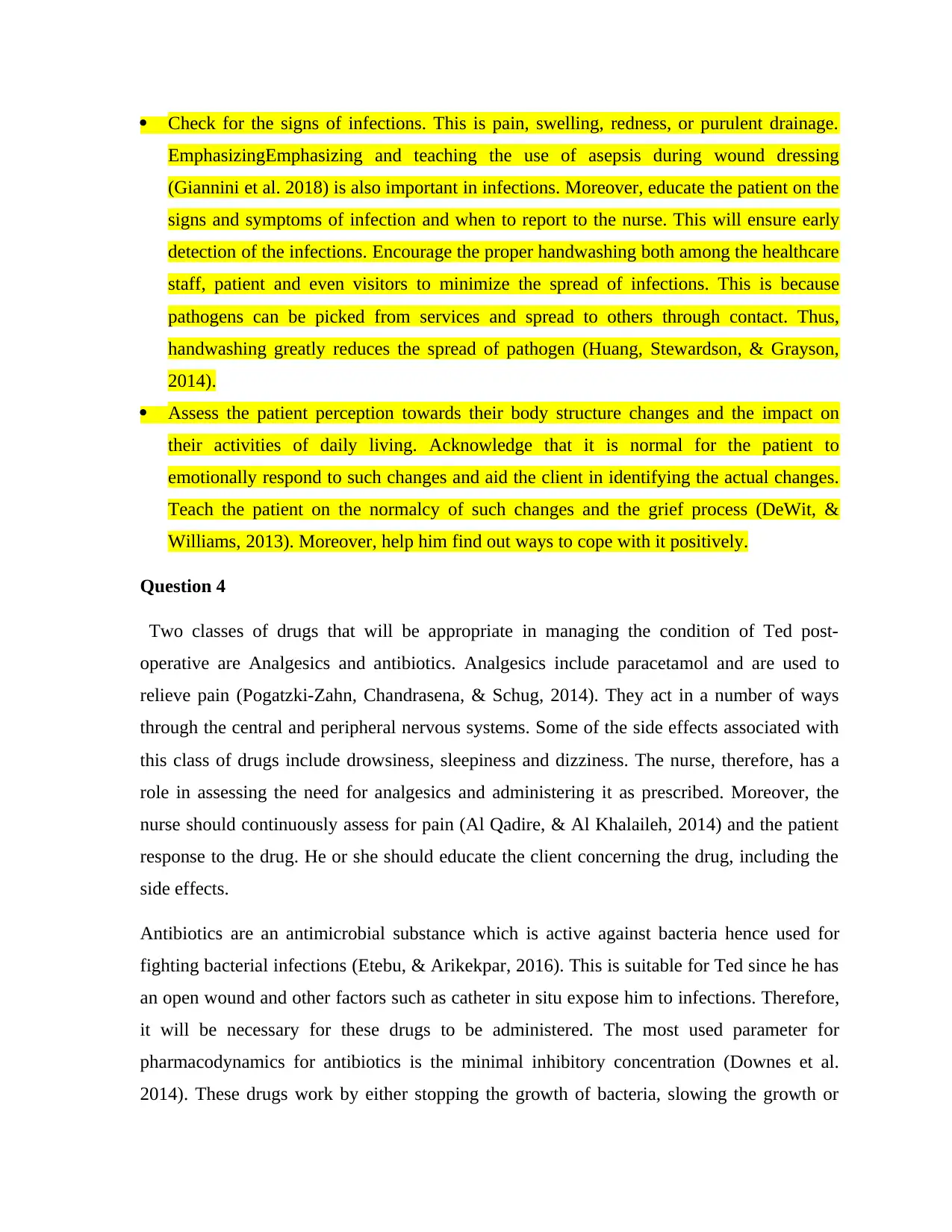
Check for the signs of infections. This is pain, swelling, redness, or purulent drainage.
EmphasizingEmphasizing and teaching the use of asepsis during wound dressing
(Giannini et al. 2018) is also important in infections. Moreover, educate the patient on the
signs and symptoms of infection and when to report to the nurse. This will ensure early
detection of the infections. Encourage the proper handwashing both among the healthcare
staff, patient and even visitors to minimize the spread of infections. This is because
pathogens can be picked from services and spread to others through contact. Thus,
handwashing greatly reduces the spread of pathogen (Huang, Stewardson, & Grayson,
2014).
Assess the patient perception towards their body structure changes and the impact on
their activities of daily living. Acknowledge that it is normal for the patient to
emotionally respond to such changes and aid the client in identifying the actual changes.
Teach the patient on the normalcy of such changes and the grief process (DeWit, &
Williams, 2013). Moreover, help him find out ways to cope with it positively.
Question 4
Two classes of drugs that will be appropriate in managing the condition of Ted post-
operative are Analgesics and antibiotics. Analgesics include paracetamol and are used to
relieve pain (Pogatzki-Zahn, Chandrasena, & Schug, 2014). They act in a number of ways
through the central and peripheral nervous systems. Some of the side effects associated with
this class of drugs include drowsiness, sleepiness and dizziness. The nurse, therefore, has a
role in assessing the need for analgesics and administering it as prescribed. Moreover, the
nurse should continuously assess for pain (Al Qadire, & Al Khalaileh, 2014) and the patient
response to the drug. He or she should educate the client concerning the drug, including the
side effects.
Antibiotics are an antimicrobial substance which is active against bacteria hence used for
fighting bacterial infections (Etebu, & Arikekpar, 2016). This is suitable for Ted since he has
an open wound and other factors such as catheter in situ expose him to infections. Therefore,
it will be necessary for these drugs to be administered. The most used parameter for
pharmacodynamics for antibiotics is the minimal inhibitory concentration (Downes et al.
2014). These drugs work by either stopping the growth of bacteria, slowing the growth or
EmphasizingEmphasizing and teaching the use of asepsis during wound dressing
(Giannini et al. 2018) is also important in infections. Moreover, educate the patient on the
signs and symptoms of infection and when to report to the nurse. This will ensure early
detection of the infections. Encourage the proper handwashing both among the healthcare
staff, patient and even visitors to minimize the spread of infections. This is because
pathogens can be picked from services and spread to others through contact. Thus,
handwashing greatly reduces the spread of pathogen (Huang, Stewardson, & Grayson,
2014).
Assess the patient perception towards their body structure changes and the impact on
their activities of daily living. Acknowledge that it is normal for the patient to
emotionally respond to such changes and aid the client in identifying the actual changes.
Teach the patient on the normalcy of such changes and the grief process (DeWit, &
Williams, 2013). Moreover, help him find out ways to cope with it positively.
Question 4
Two classes of drugs that will be appropriate in managing the condition of Ted post-
operative are Analgesics and antibiotics. Analgesics include paracetamol and are used to
relieve pain (Pogatzki-Zahn, Chandrasena, & Schug, 2014). They act in a number of ways
through the central and peripheral nervous systems. Some of the side effects associated with
this class of drugs include drowsiness, sleepiness and dizziness. The nurse, therefore, has a
role in assessing the need for analgesics and administering it as prescribed. Moreover, the
nurse should continuously assess for pain (Al Qadire, & Al Khalaileh, 2014) and the patient
response to the drug. He or she should educate the client concerning the drug, including the
side effects.
Antibiotics are an antimicrobial substance which is active against bacteria hence used for
fighting bacterial infections (Etebu, & Arikekpar, 2016). This is suitable for Ted since he has
an open wound and other factors such as catheter in situ expose him to infections. Therefore,
it will be necessary for these drugs to be administered. The most used parameter for
pharmacodynamics for antibiotics is the minimal inhibitory concentration (Downes et al.
2014). These drugs work by either stopping the growth of bacteria, slowing the growth or
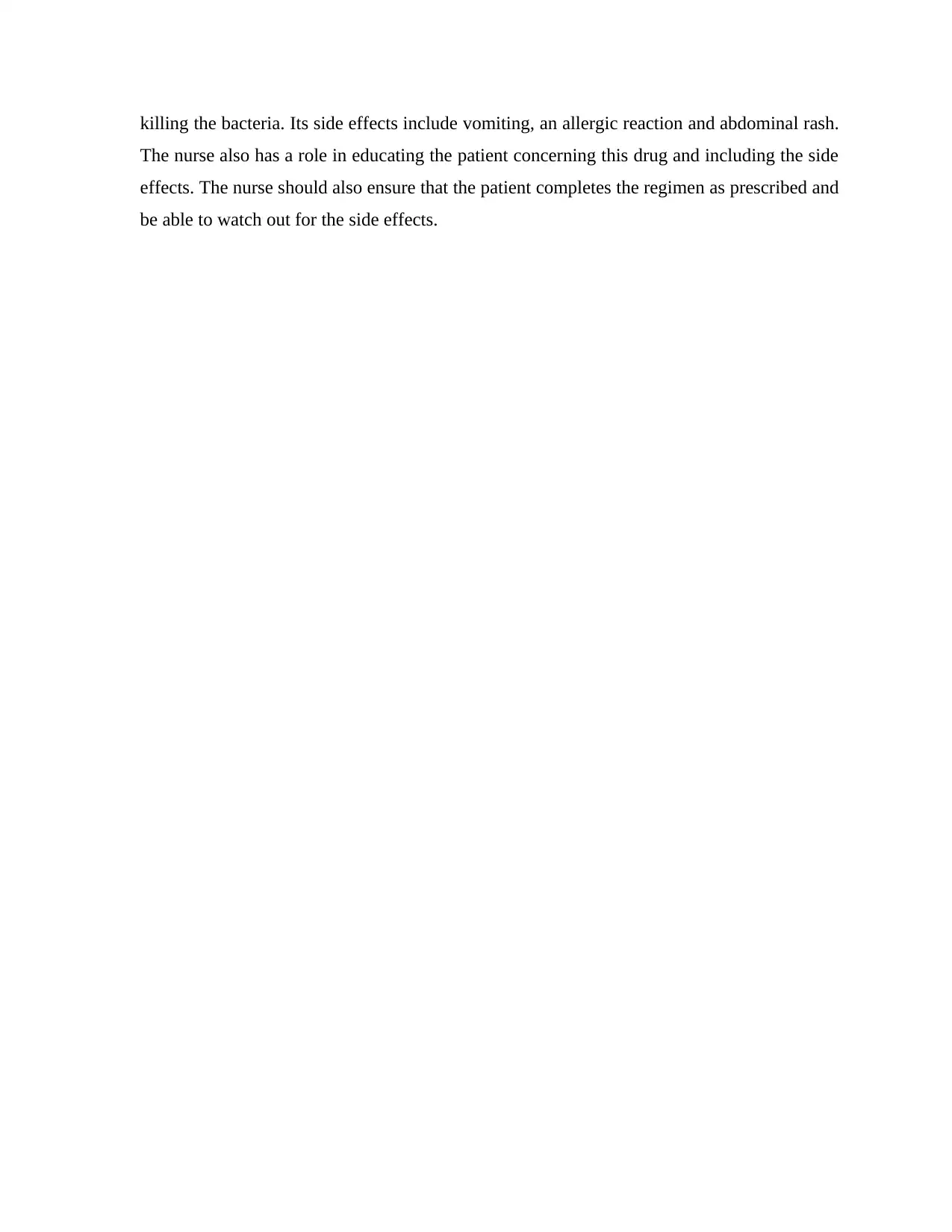
killing the bacteria. Its side effects include vomiting, an allergic reaction and abdominal rash.
The nurse also has a role in educating the patient concerning this drug and including the side
effects. The nurse should also ensure that the patient completes the regimen as prescribed and
be able to watch out for the side effects.
The nurse also has a role in educating the patient concerning this drug and including the side
effects. The nurse should also ensure that the patient completes the regimen as prescribed and
be able to watch out for the side effects.
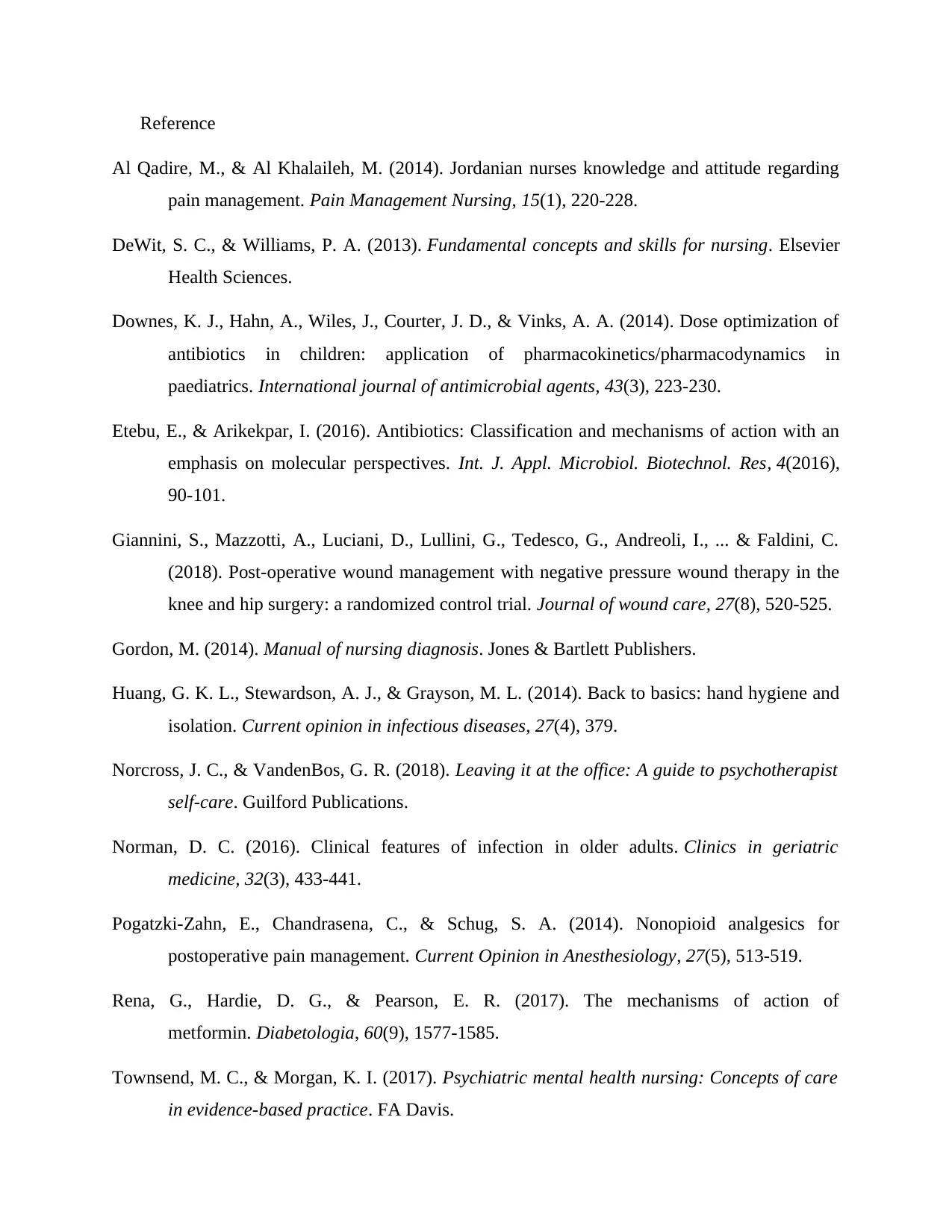
Reference
Al Qadire, M., & Al Khalaileh, M. (2014). Jordanian nurses knowledge and attitude regarding
pain management. Pain Management Nursing, 15(1), 220-228.
DeWit, S. C., & Williams, P. A. (2013). Fundamental concepts and skills for nursing. Elsevier
Health Sciences.
Downes, K. J., Hahn, A., Wiles, J., Courter, J. D., & Vinks, A. A. (2014). Dose optimization of
antibiotics in children: application of pharmacokinetics/pharmacodynamics in
paediatrics. International journal of antimicrobial agents, 43(3), 223-230.
Etebu, E., & Arikekpar, I. (2016). Antibiotics: Classification and mechanisms of action with an
emphasis on molecular perspectives. Int. J. Appl. Microbiol. Biotechnol. Res, 4(2016),
90-101.
Giannini, S., Mazzotti, A., Luciani, D., Lullini, G., Tedesco, G., Andreoli, I., ... & Faldini, C.
(2018). Post-operative wound management with negative pressure wound therapy in the
knee and hip surgery: a randomized control trial. Journal of wound care, 27(8), 520-525.
Gordon, M. (2014). Manual of nursing diagnosis. Jones & Bartlett Publishers.
Huang, G. K. L., Stewardson, A. J., & Grayson, M. L. (2014). Back to basics: hand hygiene and
isolation. Current opinion in infectious diseases, 27(4), 379.
Norcross, J. C., & VandenBos, G. R. (2018). Leaving it at the office: A guide to psychotherapist
self-care. Guilford Publications.
Norman, D. C. (2016). Clinical features of infection in older adults. Clinics in geriatric
medicine, 32(3), 433-441.
Pogatzki-Zahn, E., Chandrasena, C., & Schug, S. A. (2014). Nonopioid analgesics for
postoperative pain management. Current Opinion in Anesthesiology, 27(5), 513-519.
Rena, G., Hardie, D. G., & Pearson, E. R. (2017). The mechanisms of action of
metformin. Diabetologia, 60(9), 1577-1585.
Townsend, M. C., & Morgan, K. I. (2017). Psychiatric mental health nursing: Concepts of care
in evidence-based practice. FA Davis.
Al Qadire, M., & Al Khalaileh, M. (2014). Jordanian nurses knowledge and attitude regarding
pain management. Pain Management Nursing, 15(1), 220-228.
DeWit, S. C., & Williams, P. A. (2013). Fundamental concepts and skills for nursing. Elsevier
Health Sciences.
Downes, K. J., Hahn, A., Wiles, J., Courter, J. D., & Vinks, A. A. (2014). Dose optimization of
antibiotics in children: application of pharmacokinetics/pharmacodynamics in
paediatrics. International journal of antimicrobial agents, 43(3), 223-230.
Etebu, E., & Arikekpar, I. (2016). Antibiotics: Classification and mechanisms of action with an
emphasis on molecular perspectives. Int. J. Appl. Microbiol. Biotechnol. Res, 4(2016),
90-101.
Giannini, S., Mazzotti, A., Luciani, D., Lullini, G., Tedesco, G., Andreoli, I., ... & Faldini, C.
(2018). Post-operative wound management with negative pressure wound therapy in the
knee and hip surgery: a randomized control trial. Journal of wound care, 27(8), 520-525.
Gordon, M. (2014). Manual of nursing diagnosis. Jones & Bartlett Publishers.
Huang, G. K. L., Stewardson, A. J., & Grayson, M. L. (2014). Back to basics: hand hygiene and
isolation. Current opinion in infectious diseases, 27(4), 379.
Norcross, J. C., & VandenBos, G. R. (2018). Leaving it at the office: A guide to psychotherapist
self-care. Guilford Publications.
Norman, D. C. (2016). Clinical features of infection in older adults. Clinics in geriatric
medicine, 32(3), 433-441.
Pogatzki-Zahn, E., Chandrasena, C., & Schug, S. A. (2014). Nonopioid analgesics for
postoperative pain management. Current Opinion in Anesthesiology, 27(5), 513-519.
Rena, G., Hardie, D. G., & Pearson, E. R. (2017). The mechanisms of action of
metformin. Diabetologia, 60(9), 1577-1585.
Townsend, M. C., & Morgan, K. I. (2017). Psychiatric mental health nursing: Concepts of care
in evidence-based practice. FA Davis.
Paraphrase This Document
Need a fresh take? Get an instant paraphrase of this document with our AI Paraphraser
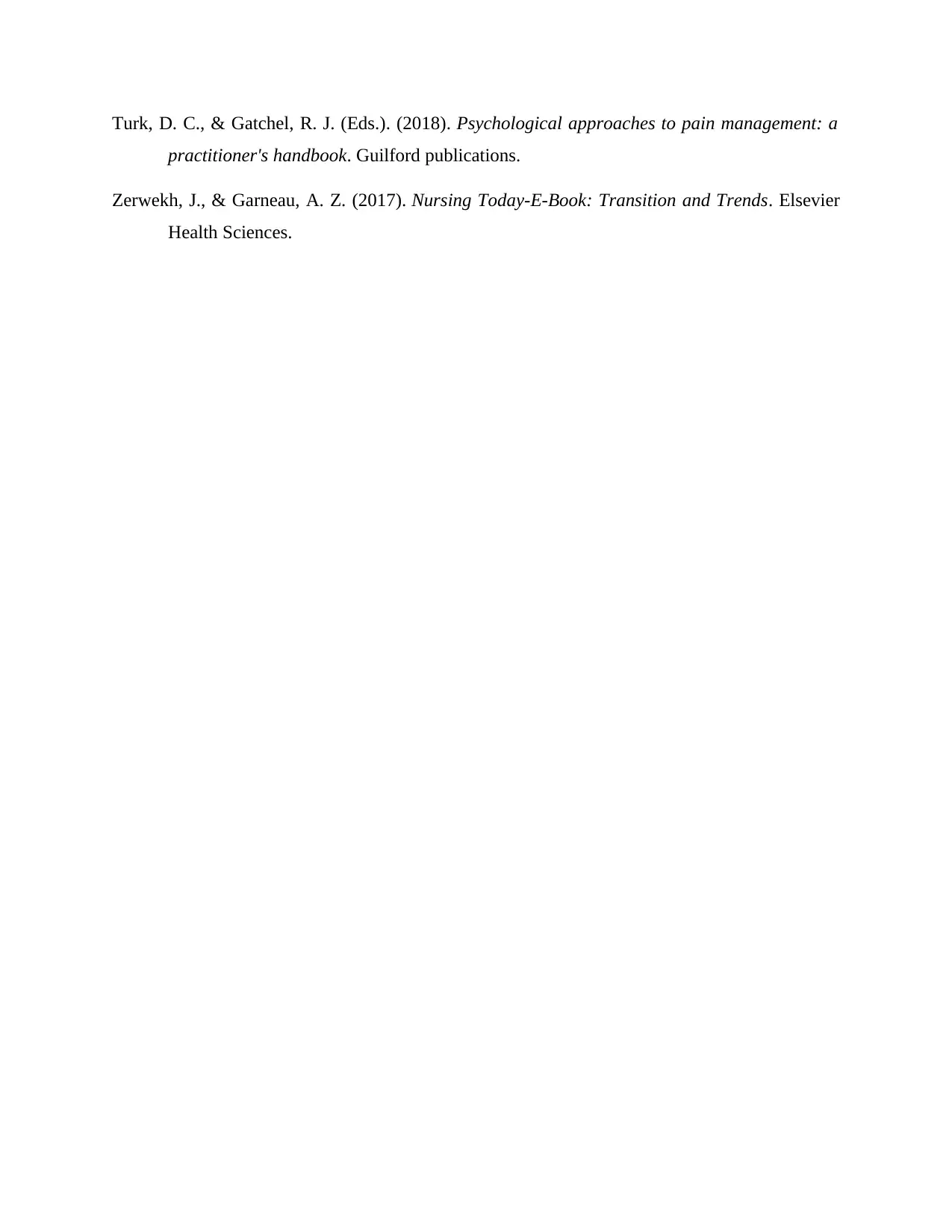
Turk, D. C., & Gatchel, R. J. (Eds.). (2018). Psychological approaches to pain management: a
practitioner's handbook. Guilford publications.
Zerwekh, J., & Garneau, A. Z. (2017). Nursing Today-E-Book: Transition and Trends. Elsevier
Health Sciences.
practitioner's handbook. Guilford publications.
Zerwekh, J., & Garneau, A. Z. (2017). Nursing Today-E-Book: Transition and Trends. Elsevier
Health Sciences.
1 out of 8
Related Documents
Your All-in-One AI-Powered Toolkit for Academic Success.
+13062052269
info@desklib.com
Available 24*7 on WhatsApp / Email
![[object Object]](/_next/static/media/star-bottom.7253800d.svg)
Unlock your academic potential
© 2024 | Zucol Services PVT LTD | All rights reserved.





